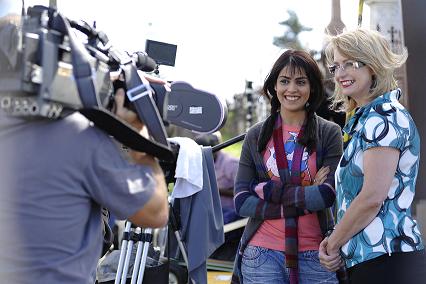All roads lead to India
 Australia and India have made news headlines for all the wrong reasons recently, but Miguel Gonzalez found their screen industries are cooperating in new creative ways that present plenty of opportunities for our practitioners.
Australia and India have made news headlines for all the wrong reasons recently, but Miguel Gonzalez found their screen industries are cooperating in new creative ways that present plenty of opportunities for our practitioners.
For years, westerners looked at the prolific Indian screen industry as an almost incomprehensible local box office phenomenon, with its long musical films and over-the-top performances.
Even before India’s Reliance ADA Group bought 50 percent of Steven Spielberg’s DreamWorks studio, it was clear that the Indian industry had reached a peak and was ready to look outside its borders to become an internationally influential film super power, just like its economic development has made it one of the nations to watch this century.
Australia and India are increasingly working together.
But how is this relationship really operating, and what is still needed to utilise the resources that India offers our practitioners? Encore had pepper chicken, daal and roti at the Sydney set of an Indian film to find out.
THE AUSTRALIAN CONNECTION
Indian-born Anupam Sharma moved to Australia two decades ago. With a Bachelors and a Masters degree in film, he was a lecturer at the University of Western Sydney when he was approached in 1998 by an Indian producer who needed someone to help with his film.
Sharma agreed to work on the project and identified a gap in the market, facilitating Indian-Australian relationships in the screen industry. With the support of Ausfilm, state agencies and companies such as Atlab (now Deluxe), Cutting Edge and The Post Lounge, he started presenting seminars in India, to inform filmmakers about how to use Australian locations and production services in their films.
“India is the most prolific film country, and Australia is one of the most professional in terms of work capacity and education. The marriage between the two has to be a win-win situation,” he explained.
The connections are not always immediately evident, but there are plenty of cases of Australian talent working on Indian projects.
When the science fiction musical Koi… Mil Gaya required aliens, Queensland-based VFX artist James Colmer was in charge of designing the creatures, while one of the action sequence directors in the very successful Om Shanti Om was Australian Angelo Sahin, who also worked as the second unit director in the film.
These are just two examples, in addition to the many screen practitioners – cinematographers, editors, etc. – residing in Mumbai and working across film and TVCs.
According to Sharma, Australian filmmakers are only just ‘discovering India’ because historically, Australia and India have ‘never looked at each other’.
“But when they have, they’ve found profitable ventures,” he said. “There is in excess of $15m worth of projects which are Australian but India-centric, and almost all of them have development funding from the government agencies.”
In Sharma’s opinion, it is easier for foreign filmmakers to open doors than it might be for an unknown local, because people assume they come “with a sense of professionalism from the west”.
“And Indians are hungry to play on the global field.”
While the cost of living in India is considerable lower than Australia, the cost of producing a film might not necessarily be that much lower.
“Locations can be expensive, plus the ‘under the table’ costs. And because labour is cheap you end up hiring more crew,” said Sharma. “The crews that worked on Slumdog Millionaire charge the same as US rates. But overall it still works out economically.”
“It depends on who you’re working with, and how you want to shoot,” said The Waiting City producer Jamie Hilton. “We acted like a local production, but you can spend a lot of money in India. It comes down to your methodologies,” he added.
VISITING INDIANS
While Bollywood has gone to exotic locations since the beginning, Indian films are increasingly looking for overseas settings for their storylines. Partly because India wants to feel more cosmopolitan, partly because it offers an attractive backdrop and – for about the equivalent of $0.25 – an escapist fantasy for those Indians who might never get to see the Sydney Opera House or the Empire State Building in real life.
Another important factor is that, with an estimated 30 million Indians residing in other countries, there is an opportunity to tell the stories of their diaspora and incorporate the places where they live into the script.
“Telling their stories is turning out to be a commercial proposition. And when Indians overseas go to an Indian film, or any Indian-themed film, they pay $14 instead of $0.25.”
Equally important has been the opportunity to receive incentives offered by countries like Australia.

